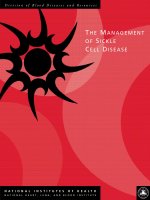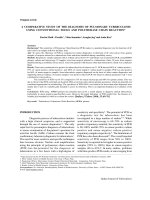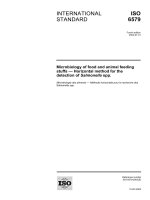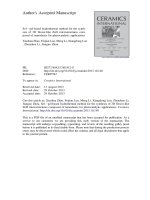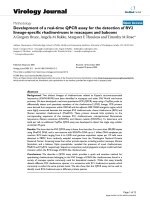A simplified and cheapest method for the diagnosis of sickle cell using whole blood PCR and RFLP in Nepal
Bạn đang xem bản rút gọn của tài liệu. Xem và tải ngay bản đầy đủ của tài liệu tại đây (276.94 KB, 8 trang )
A SIMPLIFIED AND CHEAPEST METHOD FOR
THE DIAGNOSIS OF SICKLE CELL USING
WHOLE BLOOD PCR AND RFLP IN NEPAL
Giri Raj Tripathi*
ABSTRACT
Sickle cell anemia is a serious genetic health problem dominated
in Tharu community of western Nepal. Molecular methods like PCR and
RFLP are the best method to identify Sickle c ell anemia trait. Molecular
analysis needed many steps and expensive chemicals and Kits. The aim of
this research was to develop a simple and cheapest method to process
from whole blood sample for the polymerase chain reaction (PCR) and
restriction fragment length polymorphism (RFLP) without the use of
expensive reagents and Kits. In this study molecular identification of
sickle cell traits is subjects using whole blood PCR and RFLP were
carried out. Venous blood samples collected from 800 individuals were
provided by Nepal Health Research Council (NHRC). All the obtained
samples were frozen at –80°C, and then rapidly thawed at 37°C. Then the
samples were transferred to 2 ml eppendrof tube and boiled for 10
minutes in distilled water and centrifuged at 12000 rpm for 2 minute. The
supernatant was then used directly for PCR and RFLP. For comparison,
purified DNA from the QIAGEN genomic DNA extraction kit was used as
control. PCR/RFLP results using the whole blood boiling method was
qualitatively similar to DNA extracted by using commercial Kits. The
research demonstrates that whole blood PCR and RFLP method is simple
and cheaper way for molecular diagnosis of sickle cell traits in human.
Key Words: Sickle cell anemia, whole blood, PCR, RFLP, Gel
electrophoresis.
INTRODUCTION
Sickle cell disease known as Haemoglobin SS (HBS) disease is
caused by a mutation in the beta globin gene cluster. Such mutation results
in the production of an abnormal version of the beta chain of
haemoglobin, which carry low oxygen through the body. The beta globin
gene is located on the short arm of chromosome 11. It is a member of the
globin gene family, a group of genes involved in oxygen transport. A
single nucleotide change (A to T) in the beta globin chain causes the
substitution of amino acid glutamine to valine causes the disorder sickle
cell anemia. Homozygous HbS is a serious hemoglobinopathy found
*
Dr. Tripathi is Reader in Biotechnology at Central Department of Biotechnology, Truffle
Research Programme, Tribhuvan University, Kirtipur, Kathmandu, Nepal.
58 A SIMPLIFIED AND CHEAPEST...
exclusively in the Tharu population of western Nepal. About 18 percent
Tharu people are affected with sickle cell anemia, making one of the most
prevalent genetic disorders who are ranks first as the inherited sickle cell
endemic population in Nepal (Tripathi, G.R., 2015).
Cellulose acetate electrophoresis is a cheap method to diagnose
the sickle cell disease which is commonly use in Central Hospital of
Nepal (Adhikari, et al., 2003). This method has demerits where
quantitative densitometry of abnormal hemoglobins is inaccurate at low
concentrations (HbA2, HbF). Cellulose acetate electrophoresis is
unreliable techniques since a great percentage of hemoglobin in newborns
is HbF (Bender TR and Hobbs, LA, 2003).
Molecular techniques like Polymerase chain reaction (PCR),
restriction fragment length polymorphism (RFLP), hybridization, and
DNA sequencing are the best methods for the diagnosis of sickle cell
and other human genetic diseases.
Molecular methods require
extraction and purification of DNA from biological samples such as
blood, tissues, or body fluids. DNA extraction and purification process
needed a number of expensive chemicals, reagents, Kits and
equipments (Gross-Bellard M et al. 1973; Sambrook, A, 1989). With
the advancement of molecular biology many attempts has been carried
out to developed and simplify the procedure for DNA extraction and
purification that maintain the quality and purity of the DNA which is
suitable for the molecular processing like PCR and RFLP (Miller et al.,
1988; Ferre et al., 1989; Shibata et al., 1988; Smith et al., 2003). The
chemicals used in DNA extraction needed different chemicals like
lysozyme, proteinase K and Tween 20 which breaks and lyses the cells
(Proteous et al., 1994; Tell et.al., 2003, Zhu et al., 2005; Merk et al.,
2006; Orsini et al., 2001). In addition, various physical processes like
heating, cooling, freezing etc. (Jose et al., 2006; Dederich et al., 2002;
Banik et al., 2003; Woo et al., 2000) are also essential. Both combined
physical and chemical methods have been used for the extraction of
DNA (Jose et al., 2006; Zhu et al., 2005; Tell et al., 2003, Dederich et
al., 2002). The DNA extraction procedures are laborious, time
consuming and expensive. Now a days, faster and simpler methods
involved commercial Kits have been developed and using by almost
diagnostic and research centers. These Kits are costly and require several
steps and reagents (Smith et al., 2003; Mercier, et al., 1990).
In this study we developed a simple and cheap method for
direct PCR and RFLP from processed whole blood without using
expensive commercial DNA extraction Kit and reagents. The extracted
DNA from commercial Kits was tested by PCR and RFLP in parallel
with whole blood DNA.
TRIBHUVAN UNIVERSITY JOURNAL, VOLUME. XXX, NUMBER 2, DECEMBER 2016
59
MATERIALS AND METHODS
SAMPLES COLLECTION
Three ml of venous blood sample was taken from eight hundred
fertile aged women of western Nepal. All the blood samples were collected
by the Nepal Health Research Council (NHRC) and sent to Truffle Research
Laboratory, for sickle cell diagnosis using molecular methods. Blood samples
were obtained in EDTA tubes containing potassium EDTA as an
anticoagulant, and the samples were stored at –20°C for the further use. The
samples were analyzed at the Molecular Biology laboratory of the Truffle
Research Program, Tribhuvan University, Kathmandu, Nepal.
DNA EXTRACTION FROM KIT
DNA was extracted from individual blood sample tubes provided
by NHRC using QIAGEN genomic DNA Extraction Kit following the
manufacturer’s instructions.
DNA EXTRACTION FROM WHOLE-BLOOD SAMPLES
Blood samples were thawed at 37°C and 10 µl of sample was
taken and mixed with 490 µl of autoclaved deionized double distilled
water in a 2ml Eppendorf tube. The mixture taken in Eppendorf tube
was capped tightly and left for incubation at room temperature for 10
minute. Then the samples tubes were boiled in distilled water pot for
about 10 minutes in a gas stove. The boiled blood samples were
centrifuged at 12,000 rpm for 2 min. Finally, the 2ul of clear supernatant
was taken for PCR.
POLYMERASE CHAIN REACTION
One microliter of extracted DNA from QIAGEN Kit and 2ul of
processed supernatants from the whole-blood were taken separately in
PCR tubes. All the individual samples taken in PCR tubes were mixed
with prealiquoted 5x PCR master Mix (NEB, USA) containing 0.2 units
of Taq DNA polymerase, 10 mM Tris-HCl (pH 8.8), 50 mM (KCl), 1.5
mM MgCl2, 0.2 mM of each of the four deoxynucleotide triphosphates
(dATP, dCTP, dGTP, dTTP), 0.08% IGEPAL, 5% glycerol, and 0.05%
Tween 20. Ten picomoles of each of the following two primers were then
added to this mixture of 1: 5'- ACA CAA CTG TGT TCA CTA GC -3'
(nucleotides 1576–1595); and 2: 5'-CAA CTT CAT CCA CGT TCA CC3' (nucleotides 1486–1505) designed from NCBI Gene Bank accession no
CH471064. These primers flank a 110-bp DNA fragment of HBB gene
which is present in chromosome 11 of Homo sapines. This part was
chosen because it contains the site of mutation nearly at middle of the
PCR amplification, which made single band with Dde I restriction enzyme
digestion. The PCR mixture was then denatured at 95°C for 3 min and
followed by 35 cycles of successive alternating temperatures as follows:
60 A SIMPLIFIED AND CHEAPEST...
denaturation step at 95°C for 30 sec, annealing step at 58°C for 30 sec,
and extension step at 72°C for 1 min. A final extension was step at 72°C
for 5 min. The PCR was performed in a programmable Thermal Cycler
(T10 BioRad, USA). Agarose gel electrophoresis was carried out in 1.5%
agarose gel in Tris-acetate-EDTA (TAE) buffer (40mM Tris pH 7.6,
20mM acetic acid, 1mM EDTA pH 8.0) containing 0.5 µg/ml of ethidium
bromide to enhance visualization of DNA bands under UV light. The PCR
products were mixed with 3 µl of 6X loading buffer, loaded on as above
prepared agarose gel and run on the electrophoresis machine (BioRad,
USA) at 70V. The size marker 100 bp DNA ladder was loaded at the first
slot of the well.
RESTRICTION FRAGMENT LENGTH POLYMORPHISM
Twenty microliters of the PCR product were mixed with 1 µl of
the Dde I restriction enzyme (10,000U/ml from NEB), 5µl of buffer (10x
cut smart buffer, NEB), and 24 µl of PCR grade autoclaved millique water
was mixed to make 50 µl final volume and incubated at 37°C for 16 h.
PCR products, after restriction digestion with the Dde I, were subjected to
electrophoresis on a ethidium bromide incorporated 2% agarose gel.
These DNA bands were visualized by exposure to UV light in a gel
documentation system (BioRad, USA).
COMPARISON WITH PCR AND RFLP BY DNA EXTRACTION WITH
COMMERCIAL KIT AND WHOLE-BLOOD DNA
For comparison purposes, positive control was taken from DNA
extracted using commercial DNA extraction Kit (QIAGEN) method. One
hundred nano-grams of the purified DNA from each extraction method
were used to perform PCR and RFLP analyses, using the procedures as
described above.
RESULTS
In this experiment non sickle cell carriers’ DNA was used as a
negative control which has single restriction site when digested with the
restriction enzyme Dde I. After the restriction digestion and gel
electrophoresis the band size was occurred at around ~55 bps. If the
person is sickle cell carrier: Homozygous trait (S/S) has single band at the
size of 110 base pairs and Heterozygous trait (A/S) has two bands with the
size of 110 and ~55 base pairs.
A picture of agarose gel electrophoresis of RFLP products from
whole-blood PCR method and the DNA extracted from commercial kits is
shown in figure 1. Results of two cases are included, but all cases this
experiment gave similar results. The expected PCR amplified product size
obtained with specific primers for sickle cell mutation before digestion
with Ddel I enzyme was 110 bp. The DNA extracted by our simplified
TRIBHUVAN UNIVERSITY JOURNAL, VOLUME. XXX, NUMBER 2, DECEMBER 2016
61
method, and commercial QIAGEN genomic DNA extraction kits gave
similar result in PCR amplification and RFLP analysis (Fig.-1).
In RFLP analysis, Ddel I restriction endonuclease was used to
cleave the PCR amplicons of the HBB gene. The Dde I restriction enzyme
managed to cut the PCR amplicons produced from the whole blood by the
present method (Fig.-1). After cutting, outcome fragments were 110, 54
and 56 bp in the heterozygous case (A/S), and 110 bp in the homozygous
case (S/S) Table-1. A similar pattern was obtained whether the DNA
samples were extracted by the commercial kits. Cutting was successful in
all the samples. In addition, the cutting patterns were as expected in each
case whether it had the mutation or not.
Table-1: Mutation Abolishes Restriction Site
PCR Product Fragment Size 110 bp
Fragment Sizes After Dde I Digestion
A/A
A/S
S/S
54 + 56 bp
110 + 54 +56 bp
110 bp
Fig.-1: Agarose gel electrophoresis of a typical Sickle cell genotype
analysis of PCR product digested with Dde I restriction enzyme (NEB).
Lane M is molecular weight marker of 100bp size. Lanes B246, B252, C5,
S2 are the Heterogygous trait of the Sickle cell DNA with A/S genotype.
Lane S1 is a homozygous sickle cell trait with S/S genotype and Lane 251
is A/A genotype. In this figure Lane no B246, B252, and C5 were DNA
extracted from whole-blood boiling system and Lane C251, S1, S2 are the
Control DNA extracted from commercial genomic DNA extraction Kit
(QIAGEN).
DISCUSSION
In this research we attempted and developed the simplified
procedure to decrease cost for the DNA extraction without affecting the
quality and sample throughput. The commercial DNA extraction Kits are
62 A SIMPLIFIED AND CHEAPEST...
expensive and needed number of chemicals, reagents and steps for DNA
extraction and purification of DNA. Whole blood boiling method can
denature tissue (Coates et al., 1987), and pretreatment step for DNA
extraction can be use for different organisms like fungi, plants and
animals (Rudbeck et al., 1998). Heating blood at 95°C for 15 min had
been cytolyse cells (Panaccio et al., 1993).
The DNA extraction method we used are freezing and heating,
exposure of sample to hypotonic environment with boiling in water that
ruptured cell membrane and released the DNA. Analyses of DNA samples
obtained from whole blood processed method showed that both PCR and RFLP
results were same as genomic DNA extracted from the commercial Kits. The
method we used in this study does not require any additional reagent except
deionized distilled water used to challenge cells in a hypotonic situation that
induced cytolysis further. Also, water diluted the hemoglobin content and thus
might have reduced its inhibitory effect on PCR (Panaccio et al., 1993).
The present method is also suitable for whole blood samples
stored at –20°C for several months. Other areas of potential application of
this simple procedure may be useful for DNA sequencing, hybridization
techniques, real-time PCR, and PCR, production of DNA amplicons of
large sizes and processing of other biological specimens such as culture
cells, hair, body fluids, and bacteria.
CONCLUSION
DNA processing from whole blood PCR method is simple, cheap,
quick method for directly use in PCR and RFLP techniques. The results
compared with DNA extracted from commercial Kits and whole blood
processed method has no difference. Another benefit is whole blood
processed PCR method reduce DNA extraction Kits cost about NRs 500
per sample which can be more affordable for the poor people to diagnosis
the sickle cell trait using molecular method.
WORKS CITED
Adhikari, R.C., Shrestha, T., Shrestha, R., Subedi, R., Parajuli, K. & Dali,
S. (2003). SICKLE CELL DISEASE-CASE REPORTS. Journal
of Nepal Medical Association, 42(145), 36-38.
Banik, S., Bandyopadhyay, S. & Ganguly, S. (2003). Bioeffects of
microwave. A brief review. Bioresour Technol. 87:155–159.
Bender, T.R. & Hobbs, L.A. (2003). Haemogloginopathy diagnosis in
Neonates. Genet Test. 7(5): 224-229.
Coates, P.J., Hall, P.A., Butler, M.G. & D’Ardenne, M.G. (1987). Rapid
technique of DNA-DNA in situ hybridization on formalin fixed
tissue sections using microwave incubation. J Clin Pathol. 40:
865–869.
TRIBHUVAN UNIVERSITY JOURNAL, VOLUME. XXX, NUMBER 2, DECEMBER 2016
63
Dederich, D.A., Okwuonu, G., Garner T., Denn, A., Sutton, A., Escotto,
M., Martindale, A., Del- gado, O., Muzny, D.M., Gibbs, R.A. &
Metzker, M.L. (2002). Glass bead purification of plasmid
template DNA for high throughput sequencing of mammalian
genomes. Nucleic Acids Res. 30: e32.
Ferre, F. & Garduno, F. (1989). Preparation of crude cell extract suitable
for amplification of RNA by the polymerase chain reaction.
Nucleic Ac- ids Res. 17:2141.
Gross-Bellard, M., Oudet, P. & Chambon, P. (1973). Iso- lation of highmolecular-weight DNA from mammalian cells. Eur J Biochem.
36: 32–38.
Jose, J.J. & Brahmadathan, K.N. (2006). Evaluation of simplified DNA
extraction methods for EMM typing of group A streptococci.
Indian J Med Microbiol. 24: 127–130.
Mercier, B., Gaucher, C., Feugeas, O. & Mazurier, C. (1990). Direct PCR
from whole blood, without DNA extraction. Nucleic Acids Res.
18: 5908.
Merk, S., Meyer, H., Greiser-Wilke, I., Sprague, L.D. & Neubauer, H.
(2006). Detection of Burkholderia cepacia DNA from artificially
infected EDTA-blood and lung tissue comparing dif- ferent DNA
isolation methods. J Vet Med B Infect Dis Vet Public Health.
B53: 281–285.
Miller, S.A., Dykes, D.D. & Polesky, H.F. (1988). A simple salting out
procedure for extracting DNA from human nucleated cells.
Nucleic Acids Res. 16: 1215.
Orsini, M. & Romano-Spica , V. (2001). A microwave- based method for
nucleic acid isolation from environmental samples. Lett Appl
Microbiol. 33: 17–20.
Panaccio, M., Georgesz, M. & Lew, A. (1993). FoLT PCR: a simple PCR
protocol for amplifying DNA directly from whole blood.
Biotechniques. 14: 238–243.
Porteous, L.A., Armstrong, J.L., Seidler, R.J. & Wa- trud L.S. (1994). An
effective method to extract DNA from environmental samples for
polymerase chain reaction amplification and DNA fin- gerprint
analysis. Curr Microbiol. 29: 301–307.
Rudbeck, L. & Dissing, J. (1998). Rapid, simple alkaline extraction of
human genomic DNA from whole blood, buccal epithelial cells,
semen and forensic stains for PCR. Biotechniques. 25: 588–592.
Sambrook, A., Frintsch, B.F. & Maniatis T. (1989). Mo- lecular Cloning: A
Laboratory Manual. New York: Cold Spring Harbor Laboratory Press.
64 A SIMPLIFIED AND CHEAPEST...
Shibata, D.K., Arnheim, N. & Martin, W.J. (1988). Detec- tion of human
papilloma virus in paraffin- embedded tissue using the
polymerase chain reaction. J Exp Med. 167: 225–230.
Smith, K., Diggle, M.A. & Clarke, C.S. (2003). Compari- son of
commercial DNA extraction kits for extraction of bacterial
genomic DNA from whole-blood samples. J Clin Microbiol. 41:
2440–2443.
Smith, K., Diggle, M.A. & Clarke, S.C. (2003). Compari- son of
commercial DNA extraction kits for extraction of bacterial
genomic DNA from whole-blood samples. J Clin Microbiol. 41:
2440–2443.
Tell, L.A., Foley, J., Needham, M.L. & Walker, R.L. (2003). Comparison
of four rapid DNA extraction techniques for conventional
polymerase chain reaction testing of three Mycobacteri- um spp.
that affect birds. Avian Dis. 47: 1486–1490.
Tripathi, G.R., (2015). DNA analysis for the causes of blood anemia in
fertility aged women of Nepal. A research report submitted to the
Nepal Health Research Council, Ministry of Health, Government
of Nepal.
Zhu, K., Jin, H., Ma, Y., Ren, Z., Xiao, C., He, Z., Zhang, F. & Zhu, Q.
(2005). Wang B: A continuous ther- mal lysis procedure for the
large-scale prepa- ration of plasmid DNA. J Biotechnol. 118:
257–264.
